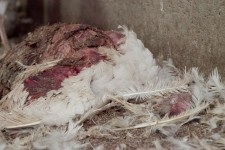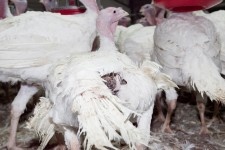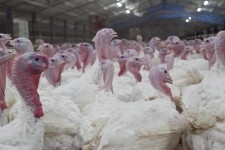- Overview
- Confinement
- Turkey poults
- Mutilation
- Artificial lighting
- Health Concerns
- Use of antibiotics
- Genetic alterations
- Muscle disorders
- Skeletal disorders
- Lame and injured birds
- Mortality rate
- Artificial insemination
- Health problems of breeders
- Slaughterhouse
- Turkeys: sentient and intelligent
- Conclusion
- References
Overview
In developed countries, more than 90% of commercial turkey production takes place in intensive production systems called factory farms(2). Turkeys raised in factory farms spend their entire lives (a grand total of three months) in crowded sheds with thousands of other birds.
The factory farming of turkeys in Australia raises significant welfare issues and is of ongoing concern to animal advocates. Inghams Enterprises Pty Ltd is the largest turkey producer in Australia, followed by Bartter which now markets Steggles. On average, between three and five million turkeys are killed annually in Australia for meat. This number is rising as turkey meat is increasingly considered a healthy dietary option.
On average, Australians eat approximately 1kg of turkey per person per year, most of which is consumed during one week at Christmas(3). The turkeys that are grown for the meat industry are killed at an average 10 - 12 weeks of age(4), when they are still only infants with unnaturally overweight distorted bodies. The toms (male turkeys) can sometimes be kept up to 16 weeks of age(5).
The life cycle of a turkey in a factory farm is, arguably, a fast and furious three months of suffering. This website presents some of the key welfare issues relating to factory-farmed turkeys in Australia.




